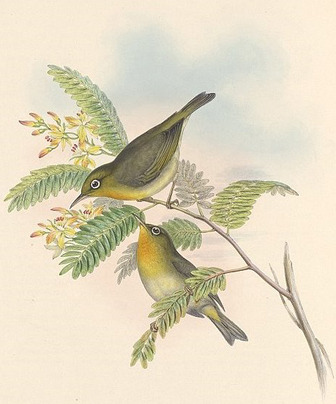Slender-billed White-eye
Its natural habitat is subtropical or tropical moist lowland forests. It is threatened by habitat loss.

The Slender-billed White-eye is classified as Endangered (EN), considered to be facing a very high risk of extinction in the wild.
Slender-billed White-eye ( Zosterops tenuirostris ) 802a16 viewsNorfolk Island March 2010Mar 30, 2010 802b_Slender-billed_White-eye_(_Zosterops_tenuirostris_)_Norfolk_Island_March_2010.jpg Slender-billed White-eye ( Zosterops tenuirostris ) 802b12 viewsNorfolk Island March 2010Mar 30, 2010 802c_Slender-billed_White-eye_(_Zosterops_tenuirostris_)_Norfolk_Island_March_2010.jpg Slender-billed White-eye ( Zosterops tenuirostris ) 802c 9 viewsNorfolk Island March 2010Mar 30, 2010 185a_Little_Penguin_(_Eudyptes_minor_)_Joesph_Banks_Group_SA_March_2010_.jpg Little Penguin ( Eudyptes minor ) 185a23 viewsJoesph Banks Group SA March 2010 Mar 30, 2010 185b_Little_Penguin_(_Eudyptes_minor_)_Joesph_Banks_Group_SA_March_2010_. More
The Slender-billed White-eye (Zosterops tenuirostris) is a species of bird in the Zosteropidae family. It is endemic to Norfolk Island. Its natural habitat is subtropical or tropical moist lowland forests. It is threatened by habitat loss. References - * BirdLife International 2004. Zosterops tenuirostris. 2006 IUCN Red List of Threatened Species. Downloaded on 27 July 2007. More
Slender-billed White-eye with chances of Red-crowned Parakeet, Scarlet Robin, and Golden Whistler. We saw our first California Quail at the start of Mt Pitt Road. Beware of the ferocious mosquitoes. Allow 1 to 1.5 hours. This is a good place to visit several times. National Parks Office - This is on the corner of Mt Pitt Road and Mission Road near the Botanic Gardens. More
Slender-billed White-eye Zosterops tenuirostris = Described by: Gould (1837) Alternate common name(s): Norfolk Island White-eye Old scientific name(s): None known by website authors Photographs No photographs are available for this species Range Norfolk Is. More
Family : Zosteropidae
Genus : Zosterops
Species : tenuirostris
Authority : Gould, 1837

